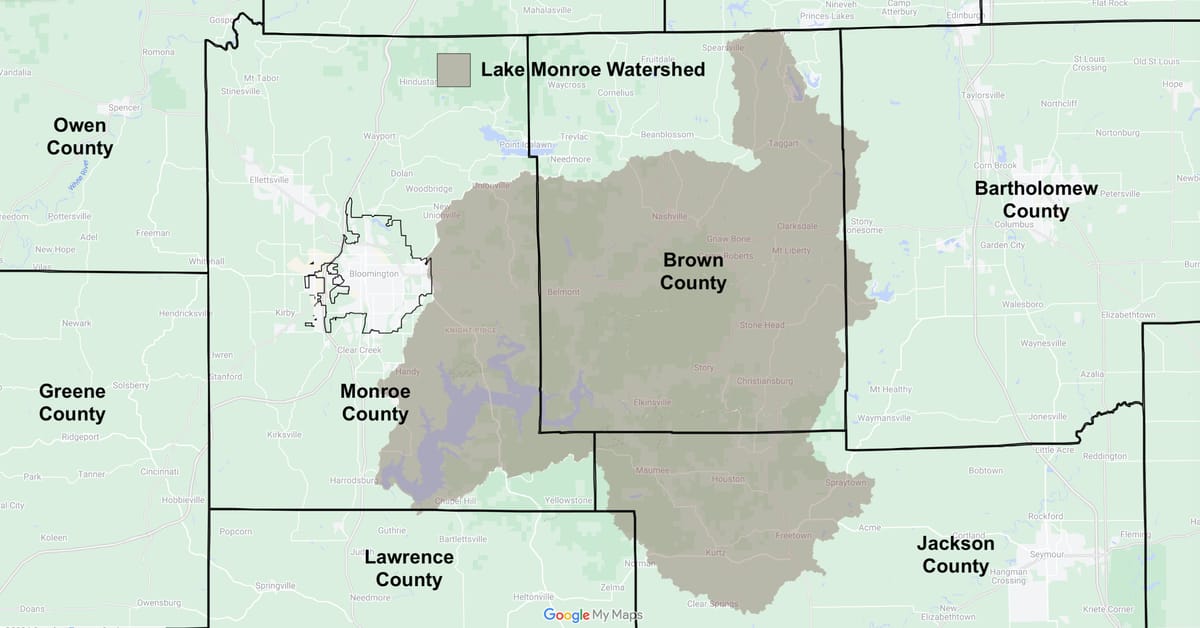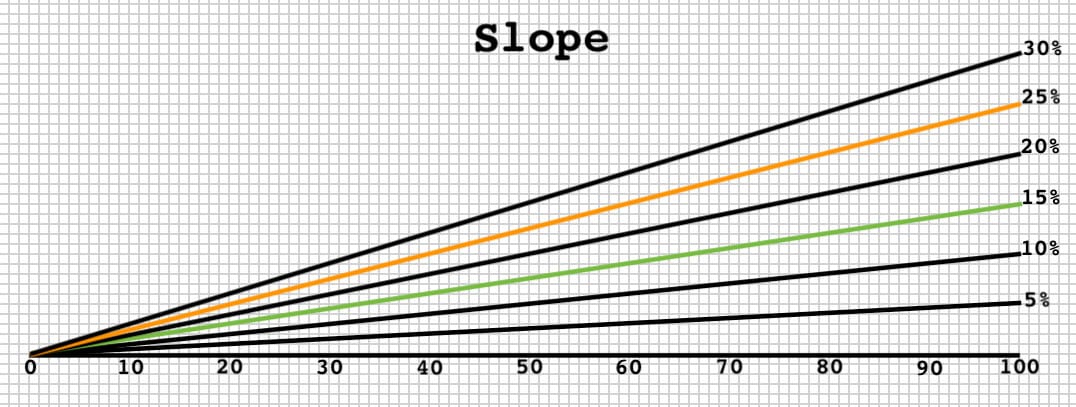Steep slopes: Monroe County still looks to curb building, despite possible state regs on local laws



On Monday at noon, several Monroe County officials gathered to strategize against a land use bill pending with Indiana’s state legislature.
The bill, which is authored by District 62 representative Dave Hall (R), would prohibit local governments in Indiana from enacting laws that prevent development on land based just on the steepness of a site’s contours.
Meeting in the county-owned portion of the Showers complex on Morton Street were county commissioners, the executive committee of the county plan commission, and county planning staff.
In Hall’s bill [HB 1108], the key notion is “slope.” The slope is a measure of steepness, defined in land use laws the same way it was in middle-school math: vertical rise / horizontal run.
To calculate the slope of a given piece of ground, the change in height (rise) is measured across the span of some horizontal distance, then divided by the length of that distance. If there’s an increase in height of 15 feet between two points that are 100 feet apart, that works out to a 15-percent slope.
Under the bill authored by Hall, local governments could not pass laws that prevent development on slopes of less than 25 percent, just because of the slope.
The idea behind local regulation of development based on steepness of slopes is based on the idea that disturbing the vegetation and soil structure can increase the likelihood of erosion. Erosion, in turn, can have negative impacts on downstream water quality,
The bill got through the house of representatives a week ago (Jan. 23) on a 69–27 vote. If it’s approved by the senate in the remaining weeks of this year’s legislative session, that will have an impact on development in the unincorporated part of Monroe County, as well as in the city of Bloomington.
Both the county and the city governments have zoning laws that restrict development on slopes of less than 25 percent. In Bloomington’s unified development ordinance (UDO), development is prohibited outright on slopes greater than 18 percent, with restrictions on slopes between 12 and 18 percent. In Monroe County’s, zoning code, there are prohibitions of development on slopes greater than 18 percent in some areas and 15 percent in others.
Hall’s District 62 includes all of Brown County, parts of Jackson County and a swath of Monroe County that does not include Bloomington.
In recognition of the fact that Lake Monroe serves Bloomington’s water supply, Hall’s bill does not apply to the entire area of the Lake Monroe watershed—which means the county’s restrictions on steep slope development would still apply in the watershed.
One focus of Monday’s strategy session, for the possible senate debate on Hall’s bill, was the wording of the carve-out for the Lake Monroe watershed. Possible amendments were mulled, including the idea that the two conditions specifying the exemption should be combined with “or” instead of “and” which would mean the exemption would apply to more areas, and Hall’s bill would apply to fewer areas.
As HB 1108 is currently worded, an exempted area has to satisfy two conditions: (1) be a watershed area of a reservoir; (2) be the source of drinking water for a municipality.
That and other possible amendments mulled by Monday’s group are indicated in square brackets below:
Sec. 14. (a) This section does not apply to development on a site that is located within an area that:
(1) the department of natural resources [Indiana Department of Environmental Management??] has determined to be the watershed area of a reservoir; and [or??]
(2) is a source of drinking water for a municipality [municipal corporation??].
On Jan. 23, during the debate on the house floor, District 61 representative Matt Pierce (D) thanked Hall for excluding the Lake Monroe watershed. But about Hall’s bill, Pierce said, that it does not look at “any other watersheds around the state to see if they might also have some similar concerns to Lake Monroe that might have concerns about soil erosion.”
In addition to objecting to Hall’s bill on the merits of steep slope development, Pierce also objected to it because it takes control away from locally elected representatives.
Pierce put it like this: “Why don’t we respect our local elected officials who are held accountable by the local citizens who elect them?” He continued, “When we pass a law like this, we not only disrespect the local elected officials who struggle with these issues, we don’t respect the citizens who voted to put those people in the office.”
Hall countered by saying he agreed with Pierce about local control: “This is something that should be in local control. And to me, the local landowner is as local as it gets.” Hall added, “And they should be able to use their properties as they best see fit.”
Hall called a 15-percent slope restriction “unduly burdensome.” In the house floor debate, Hall blamed the slope restriction for increased housing costs. He said that the 15-percent restriction “only reduces available land and for development, but also inflates home costs.”
Hall gave the example of a 50-foot-long house with nine-foot basement walls—which requires an 18-percent slope for a walkout basement. Hall said, “I personally built my own home and shop on a 20-percent slope. And after laying sod and planting grass, there is less erosion after development.”
At Monday’s strategy session, Hall’s basis for 25-percent as the right limit for development on steep slopes got some scrutiny. During the house floor debate, Hall said that some constituents of his had cited the 2007 Indiana Department of Environmental Management’s Storm Water Quality Manual, adding, “There was a section of that that mentioned slopes of 25 percent or more should be avoided.”
Getting airtime at Monday’s strategy session was the fact that the recommendation about 25 percent or more in the manual comes in the context of discouragement of development even for slopes greater than just 15 percent.
That portion of the manual reads:
Therefore, developing on slopes with a grade of 15 percent or greater should be avoided whenever feasible in order to minimize erosion, soil loss, degradation of surface water, and excessive storm water runoff. Furthermore, slopes with a grade of 25 percent or more should be avoided altogether.
At last Saturday’s legislative update hosted by the League of Women Voters, Pierce said he thinks the bill will probably pass the senate, possibly with amendments. He put it like this: “I suspect that bill is going to pass in some form.”
Even if Hall’s bill does pass, Monroe County’s storm water coordinator Kelsey Thetonia thinks it could be possible to use county design standards to mitigate against erosion in connection with steep slope development. At Monday’s strategy session Thetonia said that it should be possible “as long as [state legislators] don’t prohibit our ability to define specific design standards for development on steeper slopes.”
Thursday’s strategy session was also attended by Monroe County’s planning director Jackie Nester Jelen and the three Monroe County Commissioners—Julie Thomas, Penny Githens and Lee Jones. Also attending were president of the plan commission, Margaret Clements, and the county council’s appointee to the plan commission, Cheryl Munson.
As it moves through the senate process, HB 1108 can be tracked on the General Assembly’s website.




Comments ()